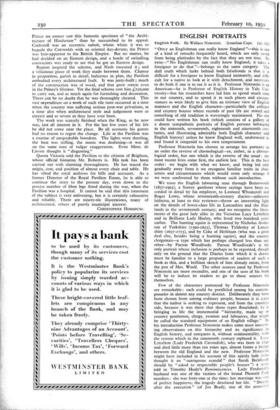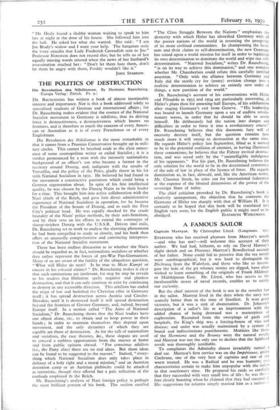ENGLISH PORTRAITS
English Folk. By Wallace Notestein. (Jonathan Cape. 12s. 6d.)
" ONLY an Englishman can really know England "—this is one of a kind of remarks frequently heard, which are only saved from being platitudes by the fact that they are not true. Its twin—" No Englishman can really know England; it takes a foreigner to do that "—belongs to the same category. The dull truth which lurks behind both falsehoods is that it is difficult for a foreigner to know England intimately, and diffi- cult for a native to look at it with detachment, and necessary to do both if one is to see it as it is. Professor Notestein is an American—he is Professor of English History in Yale Uni- versity—but his researches have led him to spend much time in our country, and to spend it in such places and circum- stances as were likely to give him an intimate view of English manners and the English character—particularly the colleges and country houses where records of past life are stored and something of old tradition is waveringly maintained. No one could have written his book (which consists of a gallery of a dozen sympathetic portraits of English persons belonging to the sixteenth, seventeenth, eighteenth and nineteenth cen- turies, and illustrating admirably both English character and English history) unless he knew England well, understood it, and found it congenial to his own temperament.
Professor Notestein has chosen to arrange his portraits in an order the reverse of chronological—or, rather, in a chrono- logical order, but one which is the reverse of the usual : the most recent lives come first, the earliest last. This is the best order : we begin with what we know, and being led only gradually away from it we recognise familiar traits in char- acters and circumstances which would seem only strange if we were confronted by them without such introduction.
We trace the English labouring man through Betteswonh (1837-1905), a Surrey gardener whose sayings have been re- corded in detail by his employer, to Leonard Wheatcroft and Roger Lowe, whose seventeenth-century diaries—unknown hitherto, at least to this reviewer—throw an interesting light on the details of lower-class life in Lancashire and the Mid- lands in the seventeenth century; and we recognise the linea- ments of the great lady alike in the Victorian Lucy Lyttelton and in Brilliana Lady Harley, who lived two hundred years earlier. The hunting squire is represented by Nicholas Asshe- ton of Yorkshire (1590-1625), Thomas Tyldesley of Lanca- shire (1657-1715), and by Coke of Holkham (who was a great deal else, besides being a hunting squire), and the country clergyman—a type which has perhaps changed less than any other—by Parson Woodforde. Parson Woodforde's is the only portrait whose inclusion is perhaps to be regretted, though only on the ground that the Diaries from which it is drawn must be familiar to a large prOportion of readers of such a book as this, and a brilliant sketch of him already exists, from the pen of Mrs. Woolf. The other sources used by Professor Notestein are more recondite, and one of the uses of his book will be to induce its readers to go to those sources for themselves.
Few of the characters portrayed by Professor Notestein are remarkable: each could be paralleled among his contem- poraries in almost any country district. Deliberately they have been chosen from among ordinary people, because it is types that the author is seeking to represent, and from the country- side, because it was there that those types flourished; he is bringing to life the immemorial "hierarchy, made up of country gentlemen, clergy, yeomen and labourers, that might be called the standard equipment of an English village." In his introduction Professor Notestein makes some most interest- ing observations on this hierarchy and its significance in English history, and compares it, without sentimentality, with the system which in the nineteenth century replaced it. Lucy Lyttelton (Lady Frederick Cavendish), who was born in 1841 and died little more than ten years ago, almost forms a bridge between the old England and the new. Professor Notestein might have included in his account of this saintly lady (who thought it an "outrageous scandal" that Sarah Bernhardt should be "asked to respectable people's houses ") a story told in Timothy Healy's Reminiscences. Lady Frederick's husband was one of the victims of the brutal Phoenix Park murders : she was forty-one at the time; her marriage was One of perfect happiness; the tragedy desolated her life. "Shortly after the execution" (of Joe Brady, one of the assassins)
"Mr. Healy found a shabby woman waiting to speak to him late at night at the door of his house. She followed him into the hall. He asked her what she wanted. She said : "I am Joe Brady's widow and I want your help. The hangman stole the ivory crucifix that Lady Frederick Cavendish sent to Joe." Professor Notestein does not record this; but he tells us of her equally moving words uttered when the news of her husband's assassination reached her : "Don't let them hate them, don't let them be angry with them, Freddy wouldn't like it."
JOHN SPARROW.















































 Previous page
Previous page